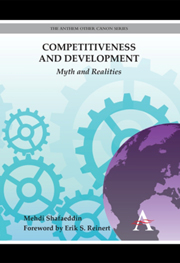Book contents
- Frontmatter
- Contents
- List of Tables, Figures and Boxes
- Foreword
- Preface
- Acknowledgements
- List of Abbreviations
- 1 Introduction: Framework of Analysis
- 2 Context and Conditions of International Competition
- 3 Alternative Theories of Competitiveness
- 4 Firm Strategy and New Industrial Organization
- 5 External Economies: Organization of Interfirm Relations
- 6 Reputation and Trust: A Firm's Relations with Stakeholders and Others
- 7 Innovation and Upgrading
- 8 Government Policies
- 9 The Experiences of China and Mexico
- 10 Summary and Concluding Remarks
- Appendices
- Bibliography
- Index
1 - Introduction: Framework of Analysis
Published online by Cambridge University Press: 05 February 2013
- Frontmatter
- Contents
- List of Tables, Figures and Boxes
- Foreword
- Preface
- Acknowledgements
- List of Abbreviations
- 1 Introduction: Framework of Analysis
- 2 Context and Conditions of International Competition
- 3 Alternative Theories of Competitiveness
- 4 Firm Strategy and New Industrial Organization
- 5 External Economies: Organization of Interfirm Relations
- 6 Reputation and Trust: A Firm's Relations with Stakeholders and Others
- 7 Innovation and Upgrading
- 8 Government Policies
- 9 The Experiences of China and Mexico
- 10 Summary and Concluding Remarks
- Appendices
- Bibliography
- Index
Summary
The problem that is usually being visualized is how capitalism administers existing structure, whereas the relevant problem is how it creates and destroys them. As long as this is not recognized, the investigator does a meaningless job.
(Schumpeter 1934, 84)The issue of competitiveness has attracted a lot of attention, both at the academic and practical levels, during the last quarter-century, i.e. since the emergence of the new economic philosophy in favour of market orientation and trade liberalization. Such development has, in turn, resulted in changes in the rules of the game in business and in international trade. Some have regarded competitiveness as an important element of success in economic performance (e.g. OECD 1992); others have considered it as a misplaced concept and an obsession (e.g. Krugman 1994). The problem is that when the concept of competitiveness is applied to developing countries, it is often delinked to economic development as though competitiveness is an end per se. If this were the case one could go to the extreme in arguing that one could sell everything at zero prices on the international market!
Some proponents of the neoclassical theory of international trade do refer to the prevalence of some market failure, particularly in the case of developing countries. Nevertheless, the orthodox theoretical background to competitiveness is the pure neoclassical theory of static comparative cost advantage (CA), which is the philosophical and ideological basis of the ‘Washington Consensus’, activities of international financial institutions and their recommendations for economic reform and universal, across-the-board trade liberalization in developing countries.
- Type
- Chapter
- Information
- Competitiveness and DevelopmentMyth and Realities, pp. 1 - 26Publisher: Anthem PressPrint publication year: 2012



